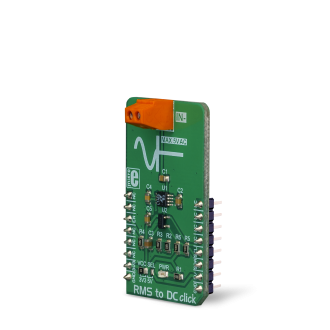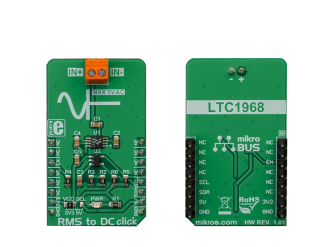
We strongly encourage users to use Package manager for sharing their code on Libstock website, because it boosts your efficiency and leaves the end user with no room for error. [more info]

Rating:
Author: MIKROE
Last Updated: 2019-01-16
Package Version: 1.0.0.0
mikroSDK Library: 1.0.0.0
Category: Measurements
Downloaded: 5396 times
Not followed.
License: MIT license
RMS to DC click is a Click board that is used to convert the RMS of the input signal into a DC voltage, with a value directly readable over the I2C interface. The Click board is equipped with the LTC1968, an RMS-to-DC converter IC, which outputs an analog voltage depending on the RMS value of the input signal.
Do you want to subscribe in order to receive notifications regarding "RMS to DC click" changes.
Do you want to unsubscribe in order to stop receiving notifications regarding "RMS to DC click" changes.
Do you want to report abuse regarding "RMS to DC click".


Library Description
The library performs an RMS to DC signal converting with 12bit resolution. It is also possible to get the averaged output DC signal (voltage), with a minimalized noise. For more details check the documentation.
Key functions:
uint16_t rms2dc_readADC( void ) - The function returns a 12bit result of AD conversion.T_RMS2DC_V rms2dc_voutADC( T_RMS2DC_V vccSel ) - The function returns the output voltage value calculated to mV, depending on the power voltage selection.T_RMS2DC_V rms2dc_avrgVoutADC( T_RMS2DC_V vccSelect, uint8_t nSamples ) - The function returns the averaged output voltage value calculated to mV, depending on the power voltage selection.Examples description
The application is composed of the three sections :
void applicationTask()
{
outVoltDC = rms2dc_avrgVoutADC( _RMS2DC_VCC_3V3, 25 );
plotData( outVoltDC );
Delay_ms( 5 );
}
Additional Functions :
Other mikroE Libraries used in the example:
ConversionsI2C LibraryUART LibraryAdditional notes and information
Depending on the development board you are using, you may need USB UART click, USB UART 2 click or RS232 click to connect to your PC, for development systems with no UART to USB interface available on the board. The terminal available in all MikroElektronika compilers, or any other terminal application of your choice, can be used to read the message.